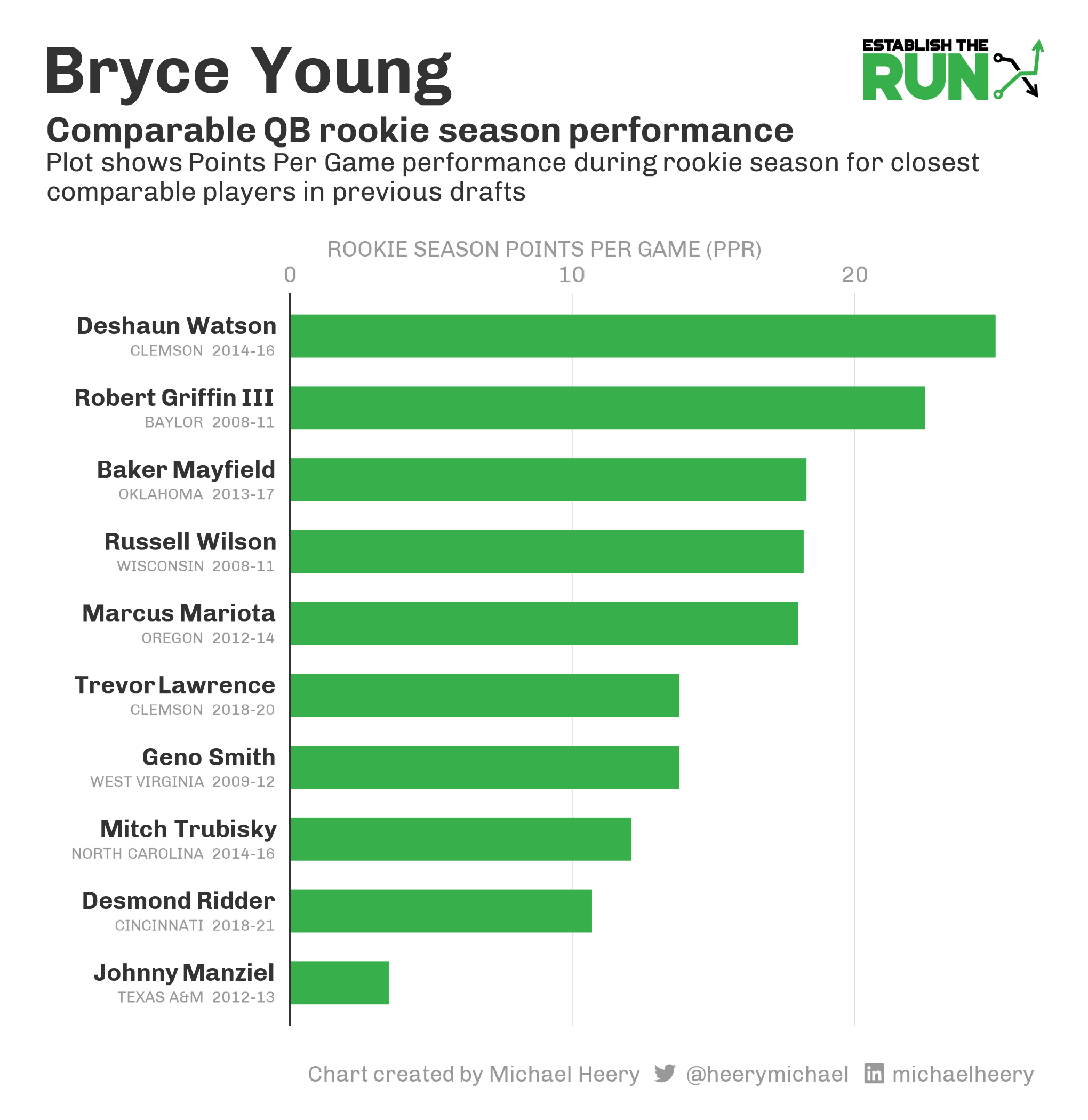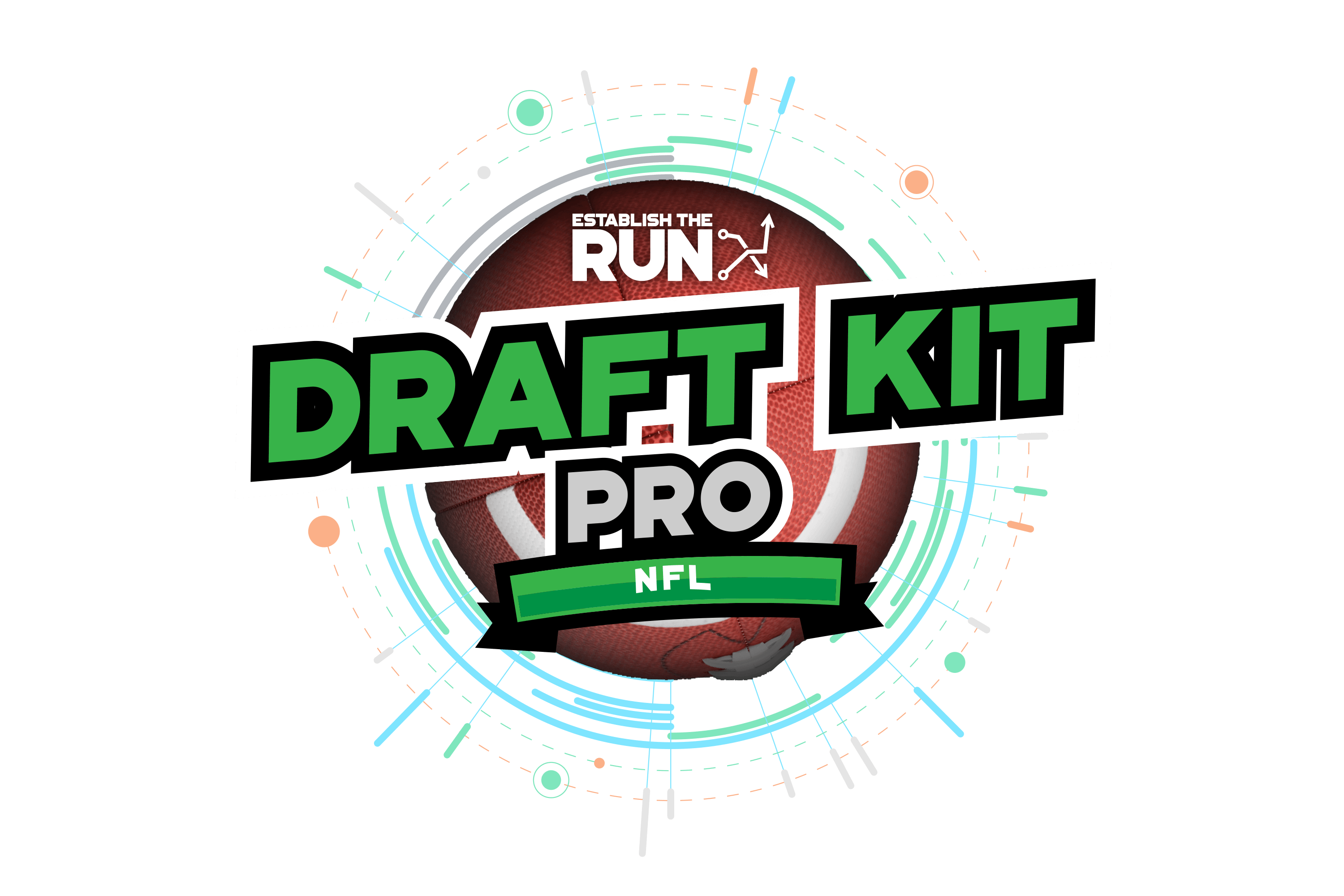Dynasty Outlook
March 17
Bryce Young is our QB3 for rookie drafts and checks in as QB14 in our overall dynasty ranks. He is an excellent prospect on paper, but it is difficult to quantify the value we should attribute to his size concerns. We have him one spot ahead of Tua Tagovailoa, who has injury issues that have already manifested themselves, but currently, our concerns are somewhat similar. Young is also not a runner, so he will have to draw most of his value from the pocket. His ceiling is equal — perhaps even better than — that of C.J. Stroud, but the floor is lower right now.
Profile Summary
Young is likely to be either the first or second pick of the draft. He appears to have just about every ability you would want in a QB. The scouts believe he is intelligent, poised, and accurate. This bears itself out in his impressive efficiency numbers. Young can also extend plays with his legs, though he is not a true runner. The issue is that he is the smallest first-round QB we’ve ever seen in the modern era. Young checked in at 5-foot-10 and 204 pounds at the Combine — and his playing weight is likely much lower than that. That brings with it some durability concerns that are difficult to account for. Young will be a fascinating case study in measurable thresholds at the position.
Vitals
Age (as of 12/31/22) — 21.4
Experience — 3 years
By the Numbers

Young has been the starting QB for the last two seasons at Alabama. In 2021, he was throwing to first- and second-round picks (respectively) in Jameson Williams and John Metchie. In 2022, the talent dropped off dramatically. Alabama’s leading receiver had just 677 yards, and nine different players had at least 10 receptions. This resulted in a minimal impact on Young’s efficiency. He averaged just 0.1 fewer yards per attempt, and still posted a 32/5 TD/INT ratio.
Young’s TD efficiency is some of the best we’ve seen. There have been six other QBs to throw for at least 70 TDs on less than 1,100 collegiate attempts, then be drafted in Round 1:
Tua Tagovailoa
Joe Burrow
Andrew Luck
Sam Bradford
Tim Tebow
C.J. Stroud (pending)
While Young possesses mobility, he is not really a running QB. His rushing total in 27 games was just 185 yards, though he did punch in seven scores. When we factor in Young’s size, it is unlikely that he will be a major contributor on the ground in the NFL.
What the Scouts are Saying
Lance Zierlein describes Young as being an excellent player in most aspects of QB play:
Slightly built with measurables that fall below the standard for the quarterback position, Young’s talent and face-of-the-franchise potential could force teams to focus more on his game film and less on his size. Young has had the advantage of working with a former NFL head coach (Bill O’Brien) who understands the challenges facing a pro quarterback. He’s a full-field reader whose confident demeanor on the field oozes off the tape but never becomes unbridled cockiness. He’s thoughtful in where he wants to go with the football and keeps the turnover count low. The deep ball is nothing special and his drive velocity fails to stand out, but he has enough arm strength to make the necessary throws. Young is perfectly capable of extending plays both inside and outside the pocket, but teams will want him to stay on schedule a little more often as a pro passer. He’s poised in the face of both physical and situational pressure and possesses a full offering of intangibles that helps set him apart from some of the more physically gifted quarterbacks in this class.
Daniel Jeremiah brings up possible durability concerns regarding Young’s size:
Young was an ultra-productive passer for Alabama. The 2021 Heisman Trophy winner has quick feet in his setup and effectively marries his eyes and feet. He remains on balance and delivers the ball accurately to all three levels. He is quick to work through progressions and throws with excellent anticipation. When he has room to step up in the pocket, he can forcefully drive the ball. When his foot space is limited, though, his ball lacks life at times. He can avoid free rushers and extend plays, always keeping his eyes up to capitalize down the field with his arm. He will take the free yards with his legs when necessary, but he’s never in run-first mode. His lack of height isn’t a major issue, but his narrow frame raises concerns about his durability at the next level. If Young can maintain his health, he should quickly emerge as a quality starting quarterback in the NFL.
Dane Brugler gives props to Young’s problem-solving ability:
While his size makes him a complete outlier as an NFL prospect, Bryce Young is an instinctive problem-solver at the quarterback position. Given his slight frame, it is fair to question his long-term durability, but Young processes his surroundings extremely well with the uncanny vision, instincts, and accuracy needed to thrive at the next level.
Draft Projection
Young currently has an expected draft position of 1.8 on Grinding the Mocks, which sources mock drafts around the interwebs. Mock Draft Database is a similar service that has Young second overall. He went second in Jeremiah’s most recent mock and was also second in Brugler’s most recent mock. The dominant opinion right now is that he will be a Houston Texan.
Comparable Players
I use Principal Component Analysis to evaluate prospects. In simplest terms, this kind of analysis looks at relevant data points to find the closest comparable players in past drafts. I prefer this to a model output — which yields only a single result — as it can display the possible range of outcomes for a prospect.
Note that the analysis itself isn’t telling us how good a player is; it is simply returning the most similar players. It is then up to us to layer in context and past results to see how good we think this player may be.

The two comps that stand out immediately for Young are Deshaun Watson and Russell Wilson, each of whom has had multiple years of high-end QB production. Trevor Lawrence appears to be on that path as well. Lawrence and Wilson are the kind of rushers we would expect Young to be. Watson ran more than those players in college, but he has settled into a similar range as a pro.
Robert Griffin III makes the list, but he doesn’t feel like a true fit given Young’s play style. The same can be said for Johnny Manziel and Marcus Mariota. Young presents an issue in terms of comps because he is such a size/efficiency/draft capital outlier.
Baker Mayfield presents a bit of a cautionary tale for the smaller passers. He has struggled with injury throughout his career. Mitchell Trubisky had similar draft capital and was also a bust.



